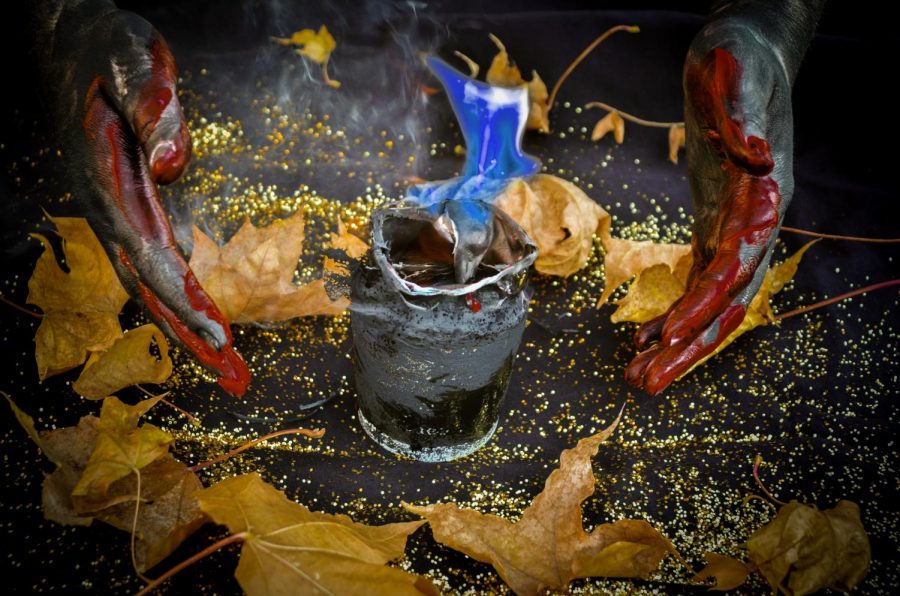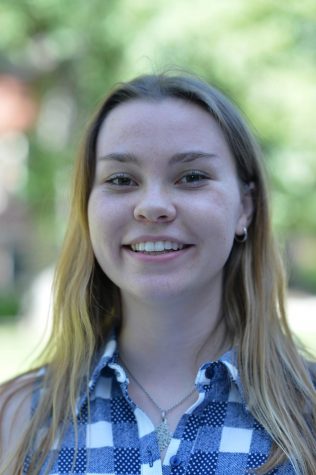Local Wiccans take advantage of Hunter’s Moon
For fresh perspectives on harnessing energy, crafting spells, this writer speaks with witches
PAIGE CAMPBELL | EVERGREEN ILLUSTRATION
Most witches and their covens focus less on casting spells and more on spending time to worship the natural world.
October 24, 2018
During this spooky week, you’ll notice the full moon’s impressive size and amber glow. October’s Hunter’s Moon has special meaning for local witches.
Halloween developed from an old pagan Celtic holiday celebrating the dead, as many people have learned. But the full moon before Hallows’ Eve, sometimes called the Hunter’s Moon or Blood Moon, plays as important a role for pagans today as it did centuries ago.
Jack-o’-lanterns, apple bobbing and witchy imagery during Halloween all harken back to pre-Christian European pagan traditions. Celtic, Germanic and Norse religions were polytheistic, and emphasized mythological creatures like giants, dwarfs, elves and spirits. They also focused on ritual and sacrifice.
Wicca is brand new by comparison. It developed in the 20th century, drawing on pre-Christian traditions from Ireland, Scotland and Wales, according to Herne, a witch writing for Wicca.com. Herne wrote that Wiccans exist under the umbrella of Witchcraft, like how Baptists exist within Christianity. Wiccans focus on nature’s divinity.
“Wicca,” Herne wrote, “is a deep appreciation and awe in watching the sunrise or sunset, the forest in the light of a glowing moon, a meadow enchanted by the first light of day.”
Herne wrote that Wiccans do not worship Satan, a “Christian creation” irrelevant to Wiccan ideology. Also, Wiccans cannot make sacrifices or cast spells on others, as these acts would conflict with their doctrine to “harm none.” Similarly, Herne stated that Wiccans should not steal life force, but instead draw from within themselves to harness the power of nature.
Groups of Wiccans on the Palouse agree with these principles. The Columbian Wicca Tradition, a further subdivision of Wicca, serves witches in the Columbia River Basin including Eastern and Central Washington, according to their accessible public website.
Though these Columbian Wiccans claim not to be malevolent, they certainly are mysterious. Their greater area’s public website leads to restricted private pages for more localized covens.
I couldn’t access information about the specific covens. Also, the public Columbia Basin site did not list names of leaders and stated that their tradition’s members do not give interviews. What we can see publicly is that a group called the Wheat & Wine Coven represents Walla Walla and the Pullman area, while the Conifer Coven is made up of witches from the Spokane, Cheney and Deer Park area.
An article in the Inlander in 2017 reported that there are several covens in Spokane alone and that some witches within them were experiencing political divides post-election. The People of the Woods coven of Spokane are politically conservative, while their High Priestess and other local witches held liberal views.
Timothy Cottrell, a local pagan practicing an Old Norse variety of paganism, said there are many types just in Pullman.
“When it comes to pagans in the community, there’s a good number of all various stripes, from Wicca to Asatru,” he said. “But when it comes to organized groups, there’s not much.”
Cottrell said his values are based in Germanic paganism, which emphasizes strong family and community connections, healthy relationships, independence, living a good and honorable life and treating others and nature well.
The administrator of Spokane Pagan Village Commons, Woods Wizard — going by his witch name — values nature and family as well. He mostly references nature in reminders he has shared with pagans in the Village Common Facebook page, rather than emphasizing spells or magic.
One of Woods Wizard’s posts advises members to be like a tree by standing strong, reaching for the sky, adapting to change, remembering their roots and always growing.
“There are a-sholes out there in any religion, but we’re far from bad people,” Cottrell said. “We’re human and we want the same things, we just don’t go about it the exact same way.”
So how are Wiccans far and near harnessing the power of the Blood Moon? Jack-o’-lanterns —pulled from Celtic Hallow’s Eve traditions — can “light the way” for spirits visiting us. Some wiccans set a place at the table with apples and other seasonal foods to feed their ancestors.
The reflective, inward energy of the season also factors into Wiccans’ decor. Dark colors incorporated into a witch’s alter can symbolize darkening skies, while dark crystals and stones like obsidian are used to help ground energy.
According to the website Pagans and Witches in Spokane, autumn is the time of year when the veil between the spiritual and the physical worlds thin. Spirits can use this time as an opportunity to hop onto our human plane of existence, and this is why Halloween’s celebration of the dead happens during this time.
Wiccans believe the October’s full moon is a beacon for spiritual energy, and encourages us to reflect on our ancestors and “blood” relatives, as stated in Llewellyn’s 2018 Witches’ Spell-A-Day Almanac.
According to the almanac, you can “thank” the moon by leaving an apple beneath a tree. Others Wiccans say the act of leaving an apple out symbolically feeds deceased family visitors.
Because of the season and the moon’s influence, Wiccans believe this full moon marks a time to research your genealogy, pour over family photo albums, hang pictures of relatives and reflect on your ancestral roots.
Though there are so many variations in the world of witchcraft, and different rituals to go with this time of year, it seems that all pagans locally and far away share one idea – do whatever feels right for you.










